This is a very modern building on an historic site at the corner of Lower Claremont Bank and St Austin Friars. It was here in the 13th century that the Austin friars established their religious house. The friary stood on a plot immediately outside the defensive stone walls around Shrewsbury. In the early 14th century, the borough allowed the friars to have a fortified postern gate through the town wall. building society for most of the 20th century. It is now a Wetherspoon pub, bearing its original name.
Illustrations and text about Montgomery’s Tower.
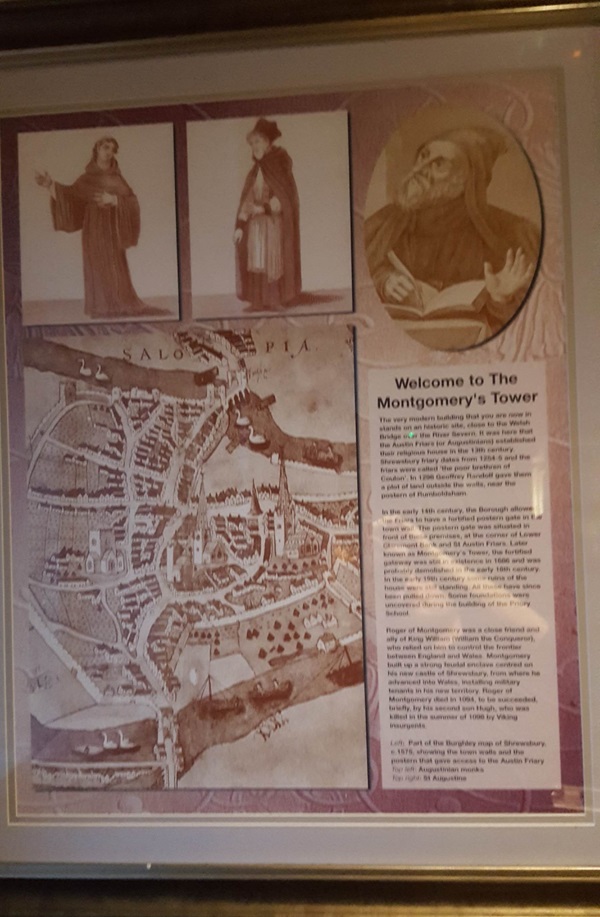
The text reads: The very modern building that you are now in stands on an historic site, close to the Welsh Bridge over the River Severn. It was here that the Austin Friars (or Augustinians) established their religious house in the 13th century. Shrewsbury Friary dates from 1254-5 and the friars were called ‘the poor brethren of Coulon’. In 1298 Geoffrey Randolf gave them a plot of land outside the walls, near the postern of Rumboldsham.
In the early 14th century, the borough allowed friars to have a fortified postern gate in the town wall. The postern gate was situated in front of these premises, at the corner of Lower Claremont Bank and St Austin Friars. Later known as Montgomery’s Tower, the fortified gateway was still in existence in 1686 and was probably demolished in the early 18th century. In the early 19th century some ruins of the house were still standing. All these have since been pulled down. Some foundations were uncovered during the building of the Priory School.
Roger of Montgomery was a close friend and ally of King William (William the Conqueror), who relied on him to control the frontier between England and Wales. Montgomery built up a strong feudal enclave centred on his new castle of Shrewsbury, from where he advanced into Wales, installing military tenants in his new territory. Roger of Montgomery died in 1094, to be succeeded, briefly, by his second son Hugh, who was killed in the summer of 1098 by Viking insurgents.
Left: Part of the Burghley map of Shrewsbury, c1575, showing the town walls and the postern that gave access to the Austin Friary
Top left: Augustinian monks
Top right: St Augustine.
Prints, illustrations and text about Charles Darwin.
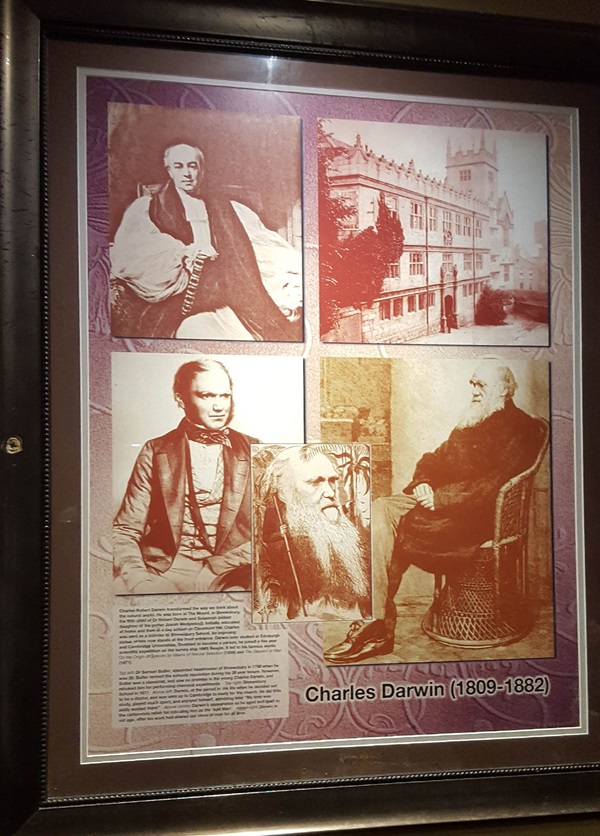
The text reads: Charles Robert Darwin transformed the way we think about the natural world. He was born at The Mount, in Shrewsbury, the fifth child of Dr Robert Darwin and Susannah (eldest daughter of Josiah Wedgwood). Initially, educated at home and then at a day school on Claremont Hill, Charles was sent as a border to Shrewsbury School. An imposing statue of him now stands at the front entrance. Darwin later studied at Edinburgh and Cambridge Universities. Destined to become a parson, he joined a five year scientific expedition on the survey ship HMS Beagle. It led to his famous works On the Origin of Species by Means of Natural Selection (1859) and The Descent of Man (1871).
Top left: Dr Samuel Butler, appointed headmaster of Shrewsbury in 1798 when he was 28. Butler revived the school’s reputation during his 38 year tenure. However, Butler was a classicist, and saw no promise in the young Charles Darwin, and rebuked him for performing chemical experiments
Top right: Shrewsbury School in 1871
Above left: Darwin at the period of his life when he decided not to be a doctor, and was sent up to Cambridge to study for the church. He did little study, played much sport, and enjoyed himself, admitting later “my time was sadly wasted there”
Above centre: Darwin’s appearance as he aged lent itself to the cartoonists relish for ridiculing him as the ‘Ape Man’
Above right: Darwin in old age, after his work had altered our ideas of man for all time.
Prints and text about Robert Clive.
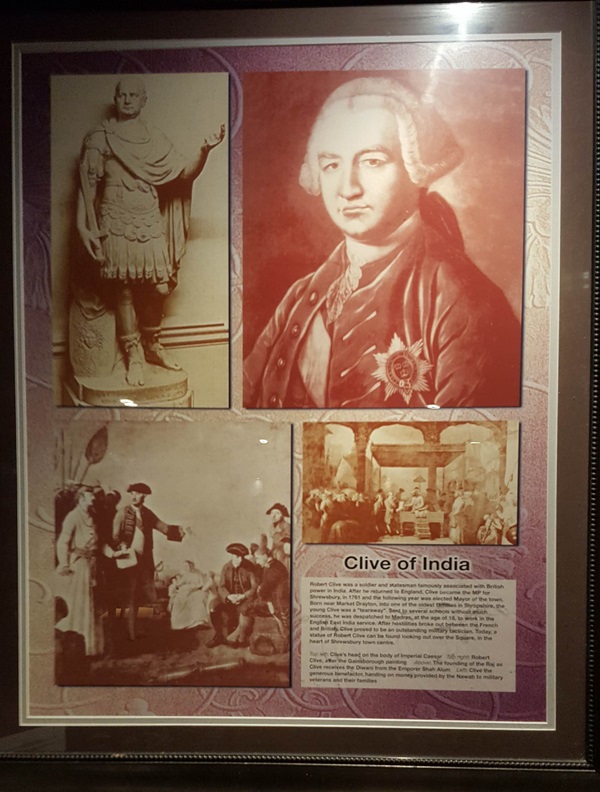
The text reads: Robert Clive was a soldier and statesman famously associated with British power in India. After he returned to England, Clive became the MP for Shrewsbury in 1761 and the following year was elected mayor of the town. Born near Market Drayton, into one of the oldest families in Shropshire, the young Clive was a tearaway. Sent to several schools without much success, he was despatched to Madras, at the age of 18, to work in the English East India service. After hostilities broke out between the French and British, Clive proved to be an outstanding military tactician. Today, a statue of Robert Clive can be found looking out over the square, in the heart of Shrewsbury town.
Top left: Clive’s head on the body of Imperial Caesar
Top right: Robert Clive, after the Gainsborough painting
Above: The founding of the Raj as Clive receives the Diwani from the Emperor Shah Alum
Left: Clive the generous benefactor, handing on money provided by the Nawab to military veterans and their families.
Illustrations and text about the history of Shrewsbury.
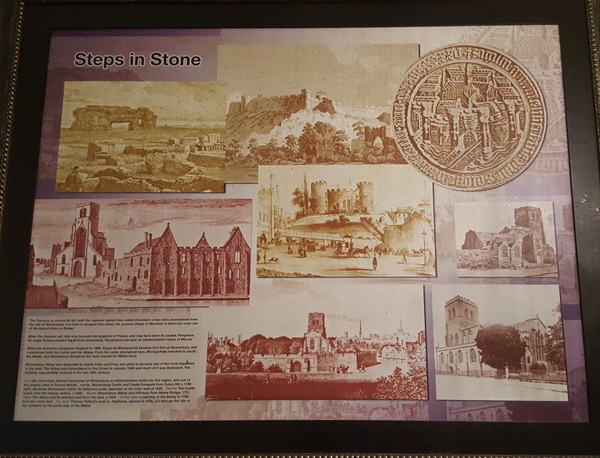
The text reads: The Romans, in around 80AD, built the regional capital they called Uriconium a few miles downstream from the site of Shrewsbury. It is hard to imagine that where the present village of Wroxeter is sited was once one of the largest cities in Britain.
When the Romans left, this area became the kingdom of Powys, and may have been its capital, Pengwern. As Anglo Saxons pushed the Britons westwards, Shrewsbury became an administrative centre of Mercia.
When the Normans conquered England in 1066, Roger de Montgomery became first Earl of Shrewsbury, and established both the castle and the abbey. From his castle stronghold here, Montgomery marched to pacify the Welsh, and Shrewsbury thrived as the main market for Welsh wool.
Shrewsbury Abbey was dedicated to Saint Peter and Paul, and grew to become one of the most important in the land. The abbey was surrendered to the Crown in January 1540 and much of it was destroyed. The building was partially restored in the late 19th century.
Top: left, Uriconium, Roman forerunner of Shrewsbury as administrative centre for this region, and one of the largest cities in Roman Britain, centre, Shrewsbury Castle and Castle Foregate from Coton Hill c1780, right, Medieval Shrewsbury within its defensive walls, depicted on the town seal of 1425
Centre: The castle looms over the railway station, c1850
Above: Shrewsbury Abbey and infirmary from Abbey Bridge, 1731
Right: The abbey and its precinct wall from the east, c1820
Centre right: A painting of the abbey in 1788 from the north east
Far right: Thomas Telford’s road to Holyhead, opened in 1836, cut through the site of the cloisters on the south side of the abbey.
External photograph of the building – main entrance.
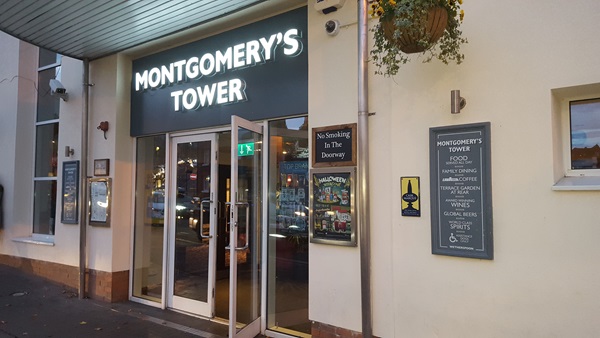
If you have information on the history of this pub, then we’d like you to share it with us. Please e-mail all information to: pubhistories@jdwetherspoon.co.uk